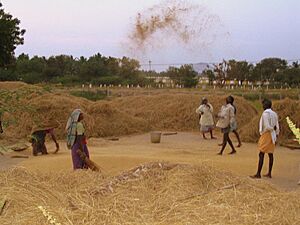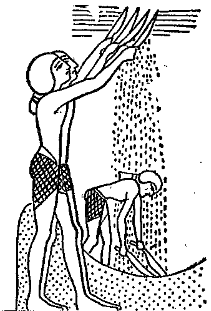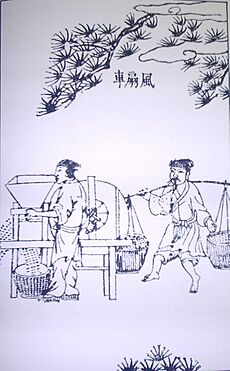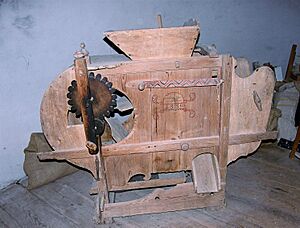Winnowing facts for kids
Winnowing is an old method used to separate the useful parts of a harvested crop, like grain, from the lighter, unwanted parts, called chaff. Imagine you've just harvested wheat. After you've removed the grain from the stalks (a process called threshing), you're left with grain mixed with light husks and dirt. Winnowing helps you clean the grain.
The simplest way to winnow is to toss the grain and chaff mixture into the air. The wind then blows away the lighter chaff, while the heavier grain falls back down. People also use special tools like a winnowing fan (a shaped basket) or a winnowing fork to help with this process. Winnowing can also help remove small pests from stored grain.
Contents
Winnowing in Ancient Greece
In ancient Greece, the winnowing-fan was called a líknon. This tool was very important in the religious ceremonies for the god Dionysus. It was also used in the Eleusinian Mysteries, which were secret religious rites. The winnowing-fan was a simple farm tool, but it became a special symbol in these religions.
Dionysus was sometimes called Dionysus Liknites, meaning "Dionysus of the winnowing fan." People believed he was awakened by women called Thyiades in a cave. The winnowing-fan connected this god to the yearly farming cycle. Interestingly, even human babies in ancient Greece were sometimes placed in a winnowing-fan, just like a cradle.
For example, in a poem about Zeus, the baby Zeus was laid in a golden líknon. In the famous story of the Odyssey, a prophet tells Odysseus to walk far from the sea with an oar. He should keep walking until someone mistakes his oar for a winnowing fan. This means he would be so far from the ocean that people wouldn't recognize a boat oar. There, he was told to build a shrine to the sea god Poseidon.
Winnowing in China
In ancient China, people made the winnowing process even better. They invented a machine called the rotary winnowing fan. This machine used a hand-cranked fan to create a strong airflow. This artificial wind helped separate the grain from the chaff much more efficiently.
This important invention was described in a book called Tiangong Kaiwu by Wang Zhen in 1313 AD. This book was like an encyclopedia of technology from that time.
Winnowing in Europe

In early Saxon villages in places like Northumberland, England, barns were built with two doors facing each other. Farmers would open both doors to create a strong draft of wind. This natural airflow was then used for winnowing, helping to clean the grain.
The advanced rotary winnowing fan, first developed in China, did not arrive in Europe until the 1700s. Dutch sailors are believed to have brought these machines to Europe between 1700 and 1720. They likely got them from the Dutch settlement of Batavia in Java, which is now part of Indonesia. Around the same time, people in Sweden also imported some from southern China. French Jesuits also brought several of these machines from China to France by 1720. Before the 18th century, Europe did not have these rotary winnowing fans.
Winnowing in the United States
The invention of the winnowing barn greatly helped rice farms in South Carolina. These special barns allowed them to clean their rice much faster and more easily. This led to a big increase in how much rice they could grow and sell.
How Winnowing Became Mechanized
In 1737, a farmer named Andrew Rodger from Scotland created a winnowing machine for corn. He called it a 'Fanner'. These machines worked very well, and his family sold them across Scotland for many years.
However, some religious leaders at the time did not like these machines. They believed that wind was created specially by God. They thought that making an artificial wind with a machine was wrong and disrespectful to God.
As the Industrial Revolution continued, more machines were invented to help with winnowing. These new machines, like fanning mills, made the process even faster and easier. This meant farmers could clean much more grain with less effort.
See also
 In Spanish: Criba para niños
In Spanish: Criba para niños






